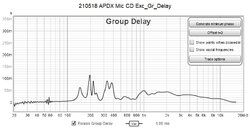Marzolino
New Member
More
- Preamp, Processor or Receiver
- Passive Line Level crossover with Vol and Bal cont
- Main Amp
- Adcom GFA 545 for woofers
- Additional Amp
- NAD 2140 for midrange
- Other Amp
- NAD 3120 for tweeters
- Universal / Blu-ray / CD Player
- Cocktail Audio X35 Music Server
- Front Speakers
- AR 3A Improved multi amp connected (NO int. xover)
- Other Equipment
- Beheringer DEQ 2496 Equalizer
Hi, I introduce myself in advance like an old enthusiast of REW, thanks to it and to John Mulcahy I've achieved a good room equalization and improved the pleasure in listening music, anyway I don't stop searching and testing moreover.
So, in the REW tutorial I read that EQ filters effectiveness, in order to modify the frequency response, is good only on that system condition defined as “Minimum Phase”, corresponding to definite frequency range(s).
The EQ filters into a minimum phase range are effective to modify the frequency response, the filters out of that range are not effective, or not reliable.
To simplify let me call that restriction as “effective range rule”.
We learn also that the effective range is displayed on the Excess Group Delay plot like a flat line.
Well, I've taken many measurements with the “Measure” standard REW procedure, then calculated the EQ filters and, for a sample of these measurements, generated the Minimum Phase and Excess Group Delay, just to check if filters drop onto the “effective range”.
The attached files show, from a single measurement taken in flat, without EQ: the SPL graph, the set of filters calculated over that measurement by REW EQ and the Excess Group delay generated by REW.
I was very happy to see, looking at the Excess Group Delay graph, that 9 of 12 filters generated drop onto the “effective range”, that is a confirmation of the REW EQ good working, but 3 of 12 filters, over not deep low frequencies (172.2 Hz, 272.9 Hz, 320.6 Hz) drop into a not “effective range”, where the Excess Group Delay plot is irregular, not a flat line.
I must say that other measurements taken in the same condition, not reported here, produced similar results.
Now, for me, these questions stay open:
Must I consider these 3 filters less regular and not reliable?
Is the “effective range rule” valid only for the very low frequencies and, if yes, which frequency could we consider as a limit?
If does that limit frequency exist could we, over that frequency, use filters without care of the minimum phase and of the “effective range rule”?
Thank you for your attention !
So, in the REW tutorial I read that EQ filters effectiveness, in order to modify the frequency response, is good only on that system condition defined as “Minimum Phase”, corresponding to definite frequency range(s).
The EQ filters into a minimum phase range are effective to modify the frequency response, the filters out of that range are not effective, or not reliable.
To simplify let me call that restriction as “effective range rule”.
We learn also that the effective range is displayed on the Excess Group Delay plot like a flat line.
Well, I've taken many measurements with the “Measure” standard REW procedure, then calculated the EQ filters and, for a sample of these measurements, generated the Minimum Phase and Excess Group Delay, just to check if filters drop onto the “effective range”.
The attached files show, from a single measurement taken in flat, without EQ: the SPL graph, the set of filters calculated over that measurement by REW EQ and the Excess Group delay generated by REW.
I was very happy to see, looking at the Excess Group Delay graph, that 9 of 12 filters generated drop onto the “effective range”, that is a confirmation of the REW EQ good working, but 3 of 12 filters, over not deep low frequencies (172.2 Hz, 272.9 Hz, 320.6 Hz) drop into a not “effective range”, where the Excess Group Delay plot is irregular, not a flat line.
I must say that other measurements taken in the same condition, not reported here, produced similar results.
Now, for me, these questions stay open:
Must I consider these 3 filters less regular and not reliable?
Is the “effective range rule” valid only for the very low frequencies and, if yes, which frequency could we consider as a limit?
If does that limit frequency exist could we, over that frequency, use filters without care of the minimum phase and of the “effective range rule”?
Thank you for your attention !














